Genus established by Lindley in l828 and published in the Botanical
Register 14 sub t. 1147.
Etymology: Greek Sophro- chaste, modest and small.
The
genus was described having as the type species Sophronitis cernua
Lindl. which has flowers that may be considered modest compared
with those of others, justifying the name used.
This genus has nine species and has as main characteristics the
fact that the plants are small, the pseudobulbs grouped, sessile
lip at the base of the column, small wings on the sides of the stigmatic
cavity and small column with eight pollinia. The color of the flowers
is mostly red and the varieties can be yellow, salmon pink, coral,
pink and red and alba is rare (see article in this issue, Professor
Doctor Agnaldo Arroyo on chemicals related to the colors of flowers:
flavonoids, carotenoids and Chlorophyll). |
| Species |
occurrence
in Brazil |
Altitude |
Cassio
Van den Berg proposition (*) |
| S. acuensis Fowl. |
RJ |
1800/2100m |
Cattleya acuensis (Fowlie) Van den Berg] |
| S. alagoensis Castro Neto & Chiron |
AL |
150/840m |
Cattleya alagoensis (V. P. Cristo & Chiron)
Van den Berg |
| S. bicolor Miranda |
ES |
|
Cattleya dichroma Van den Berg |
| S. brevipedunculata (Cogn.) Fowl. |
ES, MG, RJ |
1.500/2000m |
Cattleya brevipedunculata (Cogn.) Van den
Berg |
| S. cernua Lindl. |
AL, BA, ES, GO, MG, PE, PR, RJ, RS, SC, SP |
nível do mar até 700m |
Cattleya cernua (Lindl.) Van den Berg |
| S. coccinea (Lindl. ) Rchb. f. |
MG, RJ, SP |
650/1500m |
Cattleya coccinea Lindl. |
| S. mantiqueirae Fowl |
BA, MG, PR, RJ, RS, SC, SP |
1200/1900m |
Cattleya mantiqueirae (Fowlie) Van den Berg |
| S. pygmaea (Pabst) Whitner |
ES, RJ |
|
Cattleya pygmaea (Pabst) Van den Berg |
| S. wittigiana Barb. Rodr. |
ES, MG |
700/2000m |
Cattleya wittigiana (Barb. Rodr. ) Van den
Berg |
(*)
(*) Cassio Van Den Berg, in Neodivesity 3:3-12. 2008. 3-12 "New
combinations in the genus Cattleya Lindl. (Orchidaceae)"
presents new combinations and names on Cattleya to shelter
species included in Laelia and Sophronitis genera. |
SPECIES
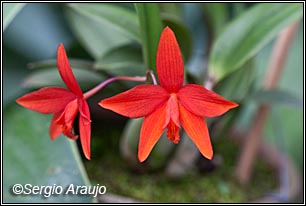 |
Sophronitis
acuensis Fowl.
Ochid Digest 39 (3):147-151- 1975 |
Etymology:
Mention the location of the habitat.
Small plant with about 5cm high. It has pseudobulbs ranging from
oval to rounded. Flowering in November and December (late spring,
early summer). The author found this species as epiphyte on Pico
Açu (hence the origin of its name), near the highest point
of the Organ Mountains, in a very restricted area but it was also
found in another area too limited growing on rocks. The variety
xanthocheila Hort. has the lip completely yellow with red
stripes (Fowlie, Orchid Digest Jan-Feb-Mar.1987). In cultivation
it requires maximum light without direct sun that can burn their
leaves.

|
 |
Sophronitis alagoensis Castro Neto & Chiron
Richardiana III(2) - avril 2003: 101.105 |
Etymology:
From Alagoas,
the Brazilian state where it comes from.
Plant found in
the state of Alagoas, vegetating at 150m altitude. It differs from
Sophronitis cernua by its size twice smaller and the flowers
are about 50% smaller. The leaves are more rounded. The lip is lobed
and slightly more elongated than in other species. The yellow part
of the lip is more spread, the callus and the column are taller.
Spring (September / November).

|

photo by Alvaro
Pessôa |
Sophronitis bicolor Miranda
Die Orchidee 42(5):277-230. 1991 |
Etymology:
From Latin bi-color with two colors, refer to the contrast of the
colorful yellow lip with red-orange of the other segments.
Robust plant, habitat, its leaves can reach up to 15cm long.
Flowers ranging from orange to red-intense, clearer externally with
lip ranging from yellow to orange with red striations. Previously
this species was known as Sophronitis coccinea from the state
of Espírito Santo.
(drawing
and information from the article by Francisco Miranda, published
inthe magazine Orchids, Volume 6 No. 2, 1992, with kind permission).
Blooming season: autumn / winter (April / June).
|
Sophronitis brevipedunculata (Cogn.) Fowlie
|
Etymology:
Brevi (short) reference to the very short stalk (peduncle).
It grows in Vellozia or directly on the rocks covered by lichen
and small vegetation.
Described as Sophronitis wittigiana var. brevipedunculata
Cogn. and published in Flora Brasiliensis, Vol III, Part V page
318. However, the differences he noticed making him to write "a
distinct species?".
According to Flowlie (Orchid Digest Jan-Feb-Mar 1987), this species
inhabits the upper reaches of the mountains and rocks growing in
Vellozia. It has very large flowers and often very good form with
very pronounced veins.
The semi-globular pseudobulbs growing in a creeping way forming
two rows, alternating left / right and even growing in pots or tree
bark it maintains this kind of growth.
The leaves are small and only one for pseudobulb. The flowers emerge
at the apex of the pseudobulbs from a very short stalk (peduncle),
hence the reason for its name. They ranges from 4 to 7.5cm diameter.
In nature, this species flowers between May and June that is, the
autumn and winter when the weather is good, sunny with very cold
nights in the altitude at which it occurs. David Miller & Richard
Warren (Organ Mountains, its history and orchids) report that the
flowering period in Macaé de Cima runs from August to October
and occasionally in April and add that the flowers last up to three
weeks.
In cultivation, keep preferably in small rough tree trunks or wooden
boards. Moderate to intense light, cold climate with reduced watering
in winter. Beware of the drainage system.
Synonym:
Sophronitis wittigiana Barb. Rodr. var. brevipedunculata
Cogn. = Sophronitis brevipedunculata (Cogn.) Fowlie.
|
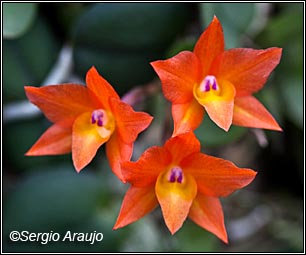 |
Sophronitis cernua Lindl.
|
Etymology:
feminine latin adjective - cernuus: prostate, creeping (Dicionário Etimológico das Orquídeas do Brasil - Pe. José
Gonzáles Raposo)
A plant found on the outskirts of Rio de Janeiro, was used to describe
the genre. It grows on trees or rocks in lowlands near the sea and
also a little further inland.
From 2 to 7 flowers emerge from a stem up to 5cm in length. The
diameter of the flowers ranges from 2 to almost 3 cm and its color
is reddish-orange and there is a "yellow" form. It blooms
during the autumn and winter. Guido Pabst, in the key to the species
of Guanabara (Rio de Janeiro city), reports that Sophrinitis
cernua has ovoid leaves, a 6-side ovary with a thin apex in
a short neck and S. pterocarpa has circular or broadly elliptical
leaves, distinctly 6-winged ovary with a thin apex in a long neck.
He also said that until that moment, he had never seen any plant
that could be identified as S. pterocarpa. It seemed to him
that accurate studies, specially based on the typical material,
will reveal the identity of this species with S. cernua.
The vegetative part is so variable that could hardly lie in a characteristic
shape of the leaf itself sufficient for separating the species.
He also said that the illustration of Kraenzlin as S. pterocarpa
nothing more than the actual S. cernua.
Sub-species and varieties (according to Fowlie):
Sophronitis cernua subs. mineira
Sophronitis cernua subs. mineira var.
endsfeldzii Hort. (pale yellow - albine)
Sophronitis cernua var cernua (also known as coastal);
Sopronitis cernua var. lowii Hort. ex Decker (lemon
yellow flowers);
It blooms in autumn and winter and the flowers can last for three
weeks.
This species and S. alagoensis are the only ones that can
be cultivated in hot climate. It should be watered copiously with
reduction during the cold days. Due to the kind of growth, it can
be cultivated in small stubs or in wood slabs.
Synonyms:
Cattleya cernua (Lindl.) Beer
Epidendrum humile Vell.
Sophronia cernua Lindl
Sophronia modesta Lindl.
Cattleya pterocarpa Beer
Sophronitis cernua var. pterocarpa Hort.
Sophronitis hoffmannseggii Rchb. f.
Sophronitis isopetala Hoffmsgg.
Sophronitis modesta Lindl.
Sophronitis nutans Hoffmsgg.
Sophronitis pterocarpa Lindl. & Paxton .
Sophronia pterocarpa (Lind. & Paxton) Kuntze |
 |
Sophronitis
coccinea (Lindl.) Rchb. f.
|
Etymology:
feminine latin adjective - coccineus: scarlet color, brilliant
red color (Dicionário Etimológico das Orquídeas
do Brasil - Pe. José Gonzáles Raposo).
Described in 1836, as Cattleya coccinea Lindl. in 1864,
it has been transferred to the genus Sophronitis. Its habitat
is placed between 600 and 1.500m altitude, in the states of Minas
Gerais, São Paulo and Rio de Janeiro. It grows on trees
or on the rocks in strong, with strong luminosity or even exposed
to direct sunlight. Plant very demanding concerning the climate
that should be cold. It needs a copiously watering during the
growth period with reduction during the winter. The flowers that
measure from 3 to 7 cm in diameter, are born of a solitary stem
that can be up to 7cm long. The base of the lip has a yellow or
orange and looms from autumn until early spring.
Ecotypes and varieties Orchid Digest Jan-Feb-Mar 1987).
Sophronitis coccinea ecotype militaris, ecotype
coccinea e ecotypeinsolaris.
Sophronitis coccinea var. rossiteriana (Barb. Rodr.)
Pabst & Dungs, var. pallens Hort, borboleta
Hort.
Synonyms:
Cattleya coccinea Lindl.
Cattleya grandiflora (Lindl.) Beer
Eunannos coccinea (Lindl.) Porto & Brade
Sophronia coccinea Kuntze
Sophronia militaris Kuntz
Sophronitis coccinea f. rossiteriana
(Barb. Rodr.) Pabst & Dungst
Sophronitis grandiflora Lindl.
Sophronitis lowii (Hort.) Curtis
Sophronitis militaris Rchb. f.
Sophronitis rossiteriana Barb. Rodri.

|
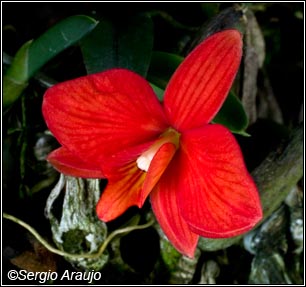 |
Sophronitis mantiqueirae (Fowlie)
Fowlie |
Etymology:
genitive of Mantiqueira (Serra da), location of the habitat
(Dicionário Etimológico das Orquídeas do Brasil
- Pe. José Gonzáles Raposo)
Originally regarded as a subspecies of S. coccinea. It grows
mainly in Minas Gerais, between 1200 and 1900m altitude with isolated
populations in several states including Bahia. Its flowers are very
similar to those of Sophronitis coccinea. The environment
is high humid and temperature in general don't exceed 20 ° C
in summer with a minimum of zero and a maximum of 15 º in winter.
It blooms in midsummer. It shares the habitat with
Dryadella lilliputana, Oncidium concolor, O. longicornu and
O gardneri. It blooms in summer.
Varieties
Sophronitis mantiqueirae var. parviflora Pabst
Sophronitis mantiqueirae var. varonica Hort. (salmon
color, from Pico de Itambé - Minas Gerais).
Synonyms:
Sophronitis
coccinea (Lindley) Rchb. f. ssp. mantiqueirae Fowlie
Sophronitis coccinea var. parvilfora Hort.
|
Sophronitis pygmaea (Pabst)
Withner
The Cattleyas and Their Relatives Volume III. Pág. 77
|
Etymology:
Feminine of pygmaeus, dwarf (Dicionário Etimológico
das Orquídeas do Brasil - Pe. José Gonzáles
Raposo).
Species discovered by Kautsky in the mountains of the state of Espírito
Santo, was initially considered as a subspecies of Sophronitis
coccinea. It grows in branches and trunks of trees or on rock,
sometimes exposed to direct sunlight. Flowers very small barely
reaching 2 cm in diameter and are born isolated from the apex of
the pseudobulbs. They are reddish-orange and the
lip is orange-yellow
and red striated. It flowers in autumn and winter. It must be grown
on slabs of wood in places with cold and high brightness without
direct sun. Very careful not to get too dried between watering.
Synonym:
Sophronitis coccinea (Lindley) Rchb. f. subsp. pygmaea
Pabst |
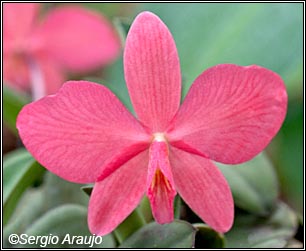 |
Sophronitis wittigiana Barb.
Rodr.
|
Etymology:
adjective formed by Wittig, name (Dicionário Etimológico
das Orquídeas do Brasil - Pe. José Gonzáles
Raposo).
It is the largest of all species of the genus, widely known as Sophronitis
rosea.
Francisco Miranda (Brazilian Orchids, Sodo Publishing, 1995, page
172) reports that this species occurs only in tropical forest in
the state of the Espírito Santo abundant and may be above
800m, where it grows in damp and shaded forest.
Érico de Freitas Machado (História do Patrimônio
Natural do Espírito Santo - Orquídeas, 2008 - página
58) shows that their color ranges from dark pink to light pink and
includes a variety alba. He also informs that it is found mainly
in the cities of Martinez Domingo, Santa Teresa and Santa Leopoldina
and its dispersion range can reach other areas of the state and
its occurrence is more constant between 600 and 900m altitude, appearing
in high branches of large trees, preferably in sparse forests, sandy
terrain where soil evaporation is more intense.
It shares the habitat with Sophronitis pygmaea, Onc. welteri,
Onc. gardineri, Cattleya warneri, C. velutina and Scuticaria
hadwenii among another species. It blooms during the winter
(June and July - South hemisphere).
Synonyms:
Sophronitis violacea O’Brien
Sophronitis grandiflora var. rosea Hort.
Sophronitis rosea Hort. ex Gatiling |
| Hybridization
In hybridization,
the importance of Sophronitis is attached to the fact reduce
dramatically the size of the resulting plant and to its ability
to convey their intense color. Therefore, his progeny is characterized
by its red or orange flowers and the small ones.
The species most used Sophronitis coccinea then with less
intensity, and Sophronitis cernua and Sophronitis brevipedunculata.
|
|
|
Sophronitis Arizona |
Sophrolaeliocattleya Jewel Box |

Sophrocattleya Mini Collins ‘ Pink
Sherbet’

Slc. Hazel Boyd |
One
of the most classic hybrid is Slc. Hazel Boyd, a cross from
Slc. California Apricot and the no less famous Slc.
Jewel Box.
In the composition, Sophronitis coccinea is dominant with
almost 30%, followed by Cattleya aurantiaca with a little
less.
According
to Álvaro Pessoa, in an article published in Orchids Volume
4 - No. 4 (1990) called "Sophronitis, contributing to
miniaturization of Cattleyas, " it was not just the size that
made this genre decisive. He stresses that the original red can
not overcome the yellow, but on the other hand, emphasizes the magenta
of lilacs, gives the color of "pitanga" when crossed with
shades of orange; captures of spotted Cattleya schilleriana
and C. aclandiae changing into true tones of ruby and creates
unbelievable red tues.
Pitanga (Eugenia uniflora L.) small orange Brazilian fruit.
|
|
|
Potinara Free Spirit |
Sophrolaeliocatleya Barefoot Mailman |
In
contrast, the short stalk (peduncle) makes the progeny to produce
shorter peduncle or when longer, they ar drooping. Besides, it takes
too long time to be developed without the same force characteristic
of the crosses.
He adds that in some crosses, the red color only appears on the
lip.
Naturally, after so many years, these problems were minimized. |
|
|
Potinara Little Toshie |
Sophrocattleya Seagulls Raindrop
(C. Chocolate Drop x S. coccinea) |
|
|
Sophrolaeliocattleya Ayrton Senna |
Sophrolaeliocattleya Tutankamen |
|
|
Sophrolaelia (Laelia milleri x Sophronitis acuensis) |
Sophrolaelia Marriottiana |
|
|
Potinara Little Toshie 'Golden Country' - 'H &
R' |
Potinara Conrad Richards |
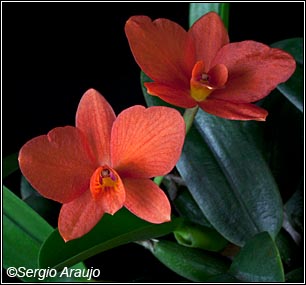 |
Sophronitis Orbiter |
Composition of the artificial hybrids including the genus Sophronitis
| Allioniara |
Allr |
Cattleya x Laelia x Myrmecophila x Sophronitis |
| Barkonitis |
Bknts |
Barkeria x Sophronitis |
| Bishopara |
Bish |
Broughtonia x Cattleya x Sophronitis |
| Brassophranthe |
Bsp |
Brassavola x Guarianthe x Sophronitis |
| Brassosophronitis |
Bnts |
Brassavola x Sophronitis |
| Buiara |
Bui |
Broughtonia x Cattleya x Epidendrum x Laelia x Sophronitis |
| Clarkeara |
Clka |
Brassavola x Cattleya x Diacrium x Laelia x Sophronitis |
| Conphronitis |
Conph |
Constantia x Sophronitis |
| Dieselara |
Dsla |
Laelia x Schomburgkia x Sophronitis |
| Epibrassonitis |
Epbns |
Brassavola x Epidendrum x Sophronitis |
| Epiphronitis |
Ephs |
Epidendrum x Sophronitis |
| Fergusonara |
Ferg |
Brassavola x Cattleya x Laelia x Schomburgkia x Sophronitis |
| Gladysyeeara |
Glya |
Brassavola x Broughtonia x Cattleya x Cattleyopsis x Diacrium x Epidendrum
x Laelia x Sophronitis |
| Guarisophleya |
Gsl |
Cattleya x Guarianthe x Sophronitis |
| Hackerara |
Hkr |
Cattleya x Epidendrum x Laelia x Oerstedella x Sophonitis |
| Hartara |
Hart |
Broughtonia x Laelia x Sophronitis |
| Hasegawara |
Hasgw |
Brassavola x Broughtonia x Cattleya x Laelia x Sophronitis |
| Hawkinsara |
Hknsa |
Broughtonia x Cattleya x Laelia x Sophronitis |
| Herbertara |
Hbtr |
Cattleya x Laelia x Schomburgkia x Sophronitis |
Higashiara |
Hgsh |
Cattleya x Diacrium x Laelia x Sophronitis |
Izumiara |
Izma |
Cattleya x Epidendrum x Laelia x Schomburgkia x Broughtonia |
Johnyeeara |
Jya |
Brassavola x Cattleya e Epidendrum x Laelia x Schmburgkia
x Sophronitis |
Kirchara |
Kir |
Cattleya x Epidendrum x Laelia x Sophronitis |
Lowara |
Low |
Brassavola x Laelia x Sophronitis |
Matsudaara |
Msda |
Barkeria x Cattleya x Laelia x Sophronitis |
Milspaughara |
Mlsp |
Brassavola x Cattleya x Laelia x Myrmecophila x Soprhonitis |
Mooreara |
Mora |
Brassavola x Broughtonia x Cattleya x Laelia x Shcomburgkia
x Sophronitis |
Nuccioara |
Nuc |
Cattleya x Caularthron x Laelia x Sophronitis |
Panczakara |
Pzka |
Brassavola x Epidendrum x Laelia x Sophronitis |
Potinara |
Pot |
Brassovola x Cattleya x Laelia x Sophronitis |
Rhynithanthe |
Rtt |
Guarianthe x Rhyncholaelia x Sophronitis |
Rynitis |
Rhn |
Rhyncholaelia x Sophronitis |
Rolfeara |
Rolf |
Brassavola x Cattleya x Sophronitis |
Rothara |
Roth |
Brassavola x Cattleya x Epidendrum x Laelia x Sophronitis |
Sallyyeeara |
Sya |
Brassavola x Broughtonia x Cattleya x Cattleyopsis
x Diacrium x Epidendrum x Laelia x Schomburgkia x Sophronitis |
Schombonitis |
Smbts |
Schomburgkia x Sophronitis |
| Severinara |
Sev |
Diacrium x Laelia x Sophronitis |
| Sophranthe |
Srt |
Guarianthe x Sophronitis |
| Sophrocattleya |
Sc |
Cattleya x Sophronitis |
| Sophrolaelia |
Sl |
Laelia x Sophronitis |
| Sophrolaeliacattleya |
Slc |
Cattleya x Laelia x Sophronitis |
| Staalara |
Staal |
Barkeria x Laelia x Sophronitis |
| Stacyara |
Stac |
Cattleya x Epidendrum x Sophronitis |
| Stanfieldara |
Sfdra |
Epidendrum x Laelia x Sophronitis |
| Trisuloara |
Tsla |
Barkeria x Brassavola x Cattleya x Epidendrum x Laelia x Sophronitis |
| Vacherotara |
Vach |
Brassavola x Broughtonia x Cattleya x Epidendrum x Laelia x Sophronitis |
| Yeeara |
Yra |
Brassavola x Broughtonia x Cattleya x Epidendrum x Laelia x Schomburgkia
x Sophronitis |
Remarks:
The
genus Sophronitis has been taken in the traditional sense
(senso) .
For the proposed changes, see the works of authors:
1- Cássio Van den Berg & Mark W. Chase, Nomenclatural
Notes on Laeliinae I, Lindleyana 15(2): 115-119.2000, (New combinations
of the genus Sophronitis to shelter Brazilian species of
Laelia, based on DNA);
2- Nomenclatural Notes on Laeliinae II, Lindleyana 16(2): 109-112.2001.
Cassio Van Den Berg, Neodivesity 3:3-12. 2008. 3-12 "New combinations
in the genus Cattleya Lindl. (Orchidaceae)" (new combinations
and names in Cattleya to shelter species included in the
genera Laelia and Sophronitis).
3- Chiron & Paiva Castro Neto, Révision des espèces
brésiliennes du genre Laelia Lindley. Richardiana II (I)
Janvier 2002 e, em Português, no site Brazilian Orchids/Orchid
News (http://www.delfinadearaujo.com/on/on17/paginas/summary.htm).
4- In
the separation of the genus Laelia proposed by Guy R. Chiron
and Vitorino P. Castro Neto, published in Richardiana II(I) Janvier
2002, the genus Hadrolaelia (Schlechter) Chiron & V.
P. Castro] was proposed to shelter the species of the section Hadrolaelia
Schltr. 1917 and part of sub-section Lobatae Cogniaux, l901,
section Crispae Pftizer of the genus Laelia as well
as the species of the genus Sophronitis, named Hadrolaelia
section Sophronitis.
Excluded concepts (Synonyms)
Sophronitis australis Cogn. = Constantia australis (Cogn.)
Porto & Brade
Sophronitis ochroleuca hort. Ex Regel = Maxillaria
parviflora (Poeppig. & Endl.) Garay
Sophronitis rupestris (Barb. Rodr.) Cogn. = Constantia
rupestris Barb. Rodrig.
Bibliografia
Barbosa Rodrigues - Iconographie des Orchidées du Brési-
edição de Samuel Sprunger - 1996
Carl L. Withner - The Cattleyas and Their Relatives Volume III -
1993
Chiron & Castro Neto - Un nouveau Sophronitis (Orchidaceae)
du Nordeste (Brésil) - Richardiana - III (2) Avril 2003
Cogniaux - Martii - Flora Brasiliensis
David Miller & Richard Warren, Orquídeas do Alto da Serra
da Mata Atlântica Pluvial do Sudeste do Brasil, l996
David Miller & Richard Warren (Serra dos Órgãos,
sua história e suas orquídeas)
Érico de Freitas Machado - História do Patrimônio
Natural do Espírito Santo - Orquídeas, 2008 - página
58
Francisco Miranda, na revista Orquidario, vol 6 nº2, 1992
Francisco Miranda ( Brazilian Orchids, Sodo Publishing, 1995, página
172)
Guido Pabst - "As Orquídeas do Estado da Guanabara"
- Revista Orquídeas Vol 28 - 1966
Jim & Barbara McQueen - Orchids of Brazil - The World of Orchids
2 1993
|
Expressly
prohibited any use of any material from this site (text, photos,
images, layout and others), without the express
permission of the authors, under penalty of prosecution. Any information
or request by e-mail bo@sergioaraujo.com |

|